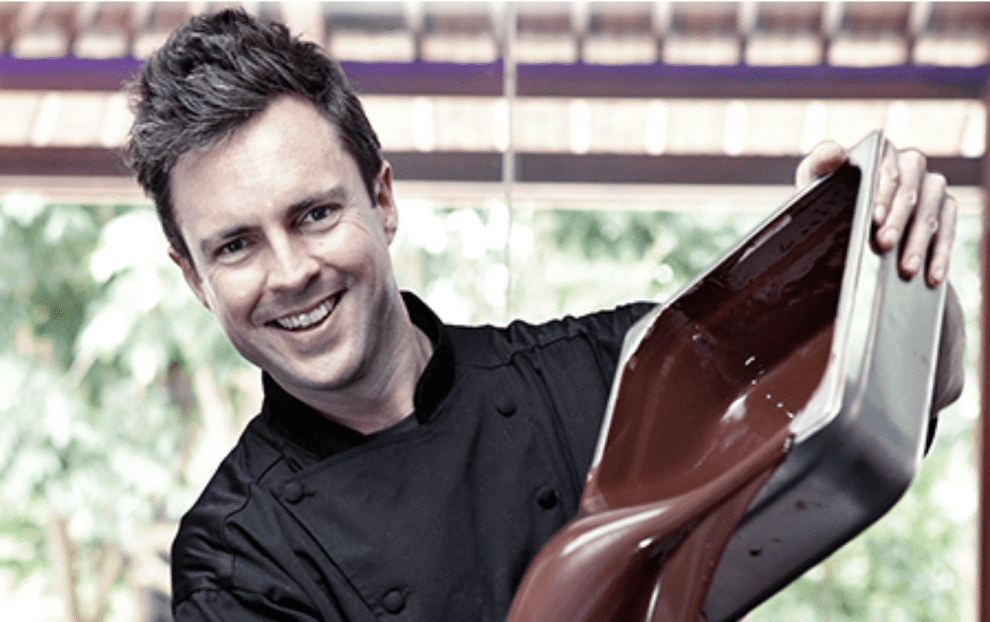After working to save Indonesian forests, an Australian man’s curiosity for chocolate led him on a remarkable journey that has transformed lives, the land and the way cocoa is grown and chocolate is made in Indonesia. Pod Chocolate is now a Balinese byword for quality and a sign of pride for those who grow the beans.
Pod Chocolate – one of the finest chocolate brands in South East Asia – began in an old, thatched hut in the shadows of the Balinese forest. It is now a symbol of both decadent indulgence and rural sustainability.
Originally from the Adelaide Hills, Toby Garritt, CEO and founder of Pod Chocolate, moved to Bali in 2001 to set up a travel company. In 2007, he sold the company and shifted his focus to environmental initiatives, working with the private sector and regional governments to protect forests and rehabilitate degraded land.
“I loved being outdoors,” he says. “I was working in Sumatra, Kalimantan and Papua. I loved the jungle noise, the orangutans,” he says.
Curious about cocoa
One day Garritt had a cocoa epiphany. “I was in a cocoa-growing region of Indonesian Papua and realised I had no idea how cocoa is produced,” he says. “I asked to see a farm.”
Cocoa trees, originally from the rainforests of Central and South America, are often planted on the fringe of the forest, where they benefit from the shelter. “A farm worker took a machete, cut off a large yellow cocoa pod from the tree and opened it up,” he remembers. “It tasted like mangosteen and soursop. But nothing like chocolate.”
Quality chocolate is made from fermented cocoa beans. The beans from fresh cocoa fruit are kept in wooden crates covered in banana leaves and allowed to ferment. During this process, yeasts and enzymes dramatically change the flavours and aromas.

While Indonesia is the third largest producer of cocoa beans, much of it is unfermented and exported for use in poor quality chocolate confectionary with a lot of sugar and palm oil. Fermentation also takes time, and farmers want to be paid for their beans straightaway.
“Indonesia is not known for its chocolate,” he says with disappointment.
“The image of chocolate is European men in chef’s hats, spooning liquid chocolate. I thought, ‘why can’t we make great chocolate where the beans are being grown’?”
The birth of Bali chocolate
Garritt hunted out small cocoa growers. “They were not paid well and their trees were neglected,” he remembers. Most were producing substandard beans. Nevertheless, he took some pods and, using rudimentary equipment, experimented relentlessly for months on end, roasting the beans to get the optimum flavour.
Meanwhile, he worked with local farmers to improve not just the quantity but the quality of their cocoa beans. Using his forestry rehabilitation knowledge, Garritt introduced farmers to composting techniques that utilised beneficial bugs and bacteria to vastly improve soil and tree health. Natural pest controls, including passive insect lures, were used to knock out pod borers and other insects that attacked the trees and their delicious fruit.
In 2010, working in a disused hut on his wife’s Bali Elephant Camp with an old coffee roaster and mortar and pestle, Garritt made his first bar of Bali chocolate.
“I took that first chocolate bar back to the farmer who grew the beans,” says Garritt. “He took a bite and his face welled up with pride. The farmer was close to crying. He was holding and tasting something he had helped to make.”
A source of pride
Self-esteem is important to any farmer. The farmers growing Pod-quality cacao beans are paid a premium for their beans. But this was a massive gamble for Garritt. Previously, the farmers were paid very little. With increased pay, there was a fear that they would start using chemical fertilisers and pesticides, completely contrary to the environmentally sustainable techniques Garritt had introduced.
The farmers, however, understood the benefits. Many have small, multi-species farms, where tropical fruit trees grow under the shade of towering timber trees, which in turn protect the small market gardens and rice paddies. These small plots are not only generations old, but also completely sustainable on a long-term basis. A patchwork of diverse farms covering Bali ensures forest cover, clean waterways, local food sources and the ability to maintain a traditional culture. The extra cash means a better existence for farmers, plus a little extra pride.
Bali icon
The old, thatched hut where the first chocolates were made in 2010 is gone. Today, surrounded by the same forest, and with elephants still neighbours, Pod Origin at Carang Sari Village is a modern chocolate workshop, cafe and visitor centre, built respectfully in the Balinese style.
Food tourists flock to try the chocolate that has changed so many lives for the better. Most recently, Garritt has opened a new, larger factory on the road to Bedugul to cater for the increased demand. The chocolate is now made using a combination of artisan techniques supported by state-of-the-art equipment, from roasting to winnowing and European conching machines. Conching ‘polishes’ the fine particles of chocolate to reduce acidity and promote flavour development. The best Pod chocolate is hand-tempered, a process that sees melted chocolate stirred and mixed to give it a beautiful, glossy finish.
“It’s a job that intimidates many in the chocolate industry, but the local villagers who work for me take to it so naturally, producing great product,” explains Garritt.
There are three ranges of Pod Chocolate, beginning with a classic range of European-style white, milk and dark couverture chocolate. The Milk range includes chocolate made with coffee beans, salted peanuts and cranberry. The Nectar Dark Chocolate range is made with nectar from the Lontar palm, producing an extraordinary, dark aromatic chocolate, flavoured with various tropical plants and spices such as lemongrass, ginger, clove and cinnamon.

Future looks sweet
Just a few years ago, 30 tonnes of Pod chocolate were made in Bali. This year there will be 80 tonnes, and Pod chocolate will expand across Indonesia. Pod chocolate is currently used by some of the best hotels and restaurants in Bali, including W Hotels, Four Seasons, Ritz Carlton, Sarong, Merah Putih and Locavore. In 2018, the chocolate will be exported to selected countries.
Trying Pod chocolate – on a tour at Pod Origin, from a café, at Denpasar Airport or at various stores dotted around the island – is now part of the Bali experience.
“My farmers look up and see a plane leaving Denpasar airport, heading to Europe, North Asia or Australia,” says Garritt. “And they know there is going to be Pod chocolate in somebody’s hand luggage. That makes them proud.”
Find out more about Pod Chocolate.
This article was originally published on Australia Unlimited and is republished here under Creative Commons.























Add Comment